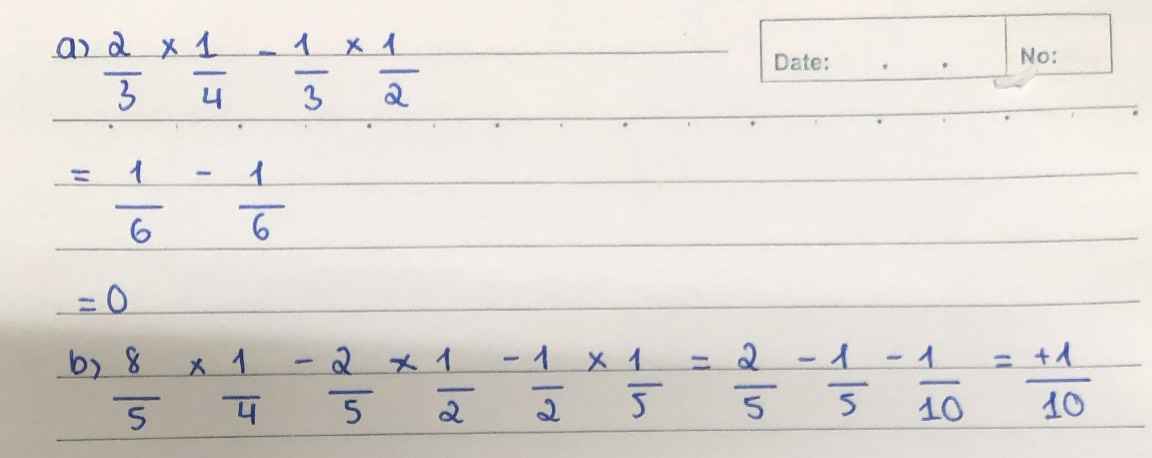X \(\times\) \(\dfrac{1}{5}\) + X \(\times\) \(\dfrac{4}{5}\) = 2 g mình với mình cần gấp X: ích x:nhân
Hãy nhập câu hỏi của bạn vào đây, nếu là tài khoản VIP, bạn sẽ được ưu tiên trả lời.


a) \(\dfrac{2}{3}\times\dfrac{1}{4}-\dfrac{1}{3}\times\dfrac{1}{2}=\dfrac{2}{12}-\dfrac{1}{6}=\dfrac{1}{6}-\dfrac{1}{6}=\dfrac{0}{6}=0\)
b) \(\dfrac{8}{5}\times\dfrac{1}{4}-\dfrac{2}{5}\times\dfrac{1}{2}-\dfrac{1}{2}\times\dfrac{1}{5}=\dfrac{8}{20}-\dfrac{2}{10}-\dfrac{1}{10}=\dfrac{4}{10}-\dfrac{2}{10}-\dfrac{1}{10}=\dfrac{4-2-1}{10}=\dfrac{1}{10}\)

a)
`2/3+5/2-3/4`
`=10/4-3/4+2/3`
`=7/4+2/3`
`=21/12+8/12`
`=29/12`
b)
`2/5xx1/2:1/3`
`=2/10xx3/1`
`=6/10=3/5`
c)
`2/9:2/9xx1/3`
`=2/9xx9/2xx1/3`
`=1xx1/3`
`=1/3`
a, \(\dfrac{2}{3}\) + \(\dfrac{5}{2}\) - \(\dfrac{3}{4}\)
= \(\dfrac{8}{12}\) + \(\dfrac{30}{12}\) - \(\dfrac{9}{12}\)
= \(\dfrac{38-9}{12}\)
= \(\dfrac{29}{12}\)
b, \(\dfrac{2}{5}\) x \(\dfrac{1}{2}\) : \(\dfrac{1}{3}\)
= \(\dfrac{1}{5}\) x \(\dfrac{3}{1}\)
= \(\dfrac{3}{5}\)
c, \(\dfrac{2}{9}\) : \(\dfrac{2}{9}\) x \(\dfrac{1}{3}\)
= 1 x \(\dfrac{1}{3}\)
= \(\dfrac{1}{3}\)

a: \(\Leftrightarrow\left(x-1\right)^2=81\)
\(\Leftrightarrow\left[{}\begin{matrix}x-1=9\\x-1=-9\end{matrix}\right.\Leftrightarrow\left[{}\begin{matrix}x=10\\x=-8\end{matrix}\right.\)

a) \(\left(\dfrac{1}{2}x-3\right)\left(-\dfrac{1}{3}+x\right)=0\)
\(\Leftrightarrow\left[{}\begin{matrix}\dfrac{1}{2}x-3=0\\-\dfrac{1}{3}+x=0\end{matrix}\right.\)
\(\Leftrightarrow\left[{}\begin{matrix}\dfrac{1}{2}x=0+3\\-\dfrac{1}{3}+x=0\end{matrix}\right.\)
\(\Leftrightarrow\left[{}\begin{matrix}x=3:\dfrac{1}{2}\\x=0-\left(-\dfrac{1}{3}\right)\end{matrix}\right.\)
\(\Leftrightarrow\left[{}\begin{matrix}x=6\\x=\dfrac{1}{3}\end{matrix}\right.\)
d) \(9x^2=1\)
\(\Leftrightarrow x^2=1:9\)
\(\Leftrightarrow x^2=\dfrac{1}{9}\)
\(\Leftrightarrow x^2=\left(\dfrac{1}{3}\right)^2\)
\(\Leftrightarrow x=\dfrac{1}{3}\)

a) \(\dfrac{2}{3}.x-\dfrac{1}{2}.x=\dfrac{5}{12}\)
=> \(\left(\dfrac{2}{3}-\dfrac{1}{2}\right).x=\dfrac{5}{12}\)
=> \(\left(\dfrac{4}{6}-\dfrac{3}{6}\right).x=\dfrac{5}{12}\)
=> \(\dfrac{1}{6}\) . x = \(\dfrac{5}{12}\)
=> \(x=\dfrac{5}{12}:\dfrac{1}{6}\)
=> x =\(\dfrac{5}{12}.\dfrac{6}{1}\)
=> x = \(\dfrac{5}{2}\)
Vậy x = \(\dfrac{5}{2}\)

1: =>|1/4x^2+1/45|=1/20
=>1/4x^2+1/45=1/20 hoặc 1/4x^2+1/45=-1/20
=>1/4x^2=1/36
=>x^2=1/36:1/4=1/9
=>x=1/3 hoặc x=-1/3
2: =(x^2-3)(x^2-2x)
=x(x-2)(x^2-3)

Để giải phương trình, ta sẽ thực hiện các bước sau: Bước 1: Giải các phép tính trong phương trình. 32x^(-1) + 2.9x^(-1) = 405(13)^(-1) + 5.(13)^2 + 1 = 1493(31)^(-1) + 5.(31)^2 + 1 = 9314(35)^(-1) Bước 2: Rút gọn các số hạng. 32x^(-1) + 2.9x^(-1) = 405/13 + 5.(13)^2 + 1 = 1493/31 + 5.(31)^2 + 1 = 9314/35 Bước 3: Đưa các số hạng về cùng mẫu số. 32x^(-1) + 2.9x^(-1) = (405/13).(31/31) + 5.(13)^2 + 1 = (1493/31).(13/13) + 5.(31)^2 + 1 = 9314/35 Bước 4: Tính toán các số hạng. 32x^(-1) + 2.9x^(-1) = 405.(31)/13.(31) + 5.(13)^2 + 1 = 1493.(13)/31.(13) + 5.(31)^2 + 1 = 9314/35 Bước 5: Tính tổng các số hạng. 32x^(-1) + 2.9x^(-1) = 405.(31)/403 + 5.(13)^2 + 1 = 1493.(13)/403 + 5.(31)^2 + 1 = 9314/35 Bước 6: Đưa phương trình về dạng chuẩn. 32x^(-1) + 2.9x^(-1) - 9314/35 = 0 Bước 7: Giải phương trình. Để giải phương trình này, ta cần biến đổi nó về dạng tương đương. Nhân cả hai vế của phương trình với 35 để loại bỏ mẫu số. 35.(32x^(-1) + 2.9x^(-1) - 9314/35) = 0 1120x^(-1) + 101.5x^(-1) - 9314 = 0 Bước 8: Tìm giá trị của x. Để tìm giá trị của x, ta cần giải phương trình này. Tuy nhiên, phương trình này không thể giải được vì x có mũ là -1.

\(a,\left(2-x\right)\left(\dfrac{4}{5}-x\right)< 0\)
=>Trong 2 số phải có 1 số âm và 1 số dương
Mà \(2-x>\dfrac{4}{5}-x\)
=>\(\dfrac{4}{5}< x< 2\)
Vậy...

A = \(\left(\dfrac{\sqrt{x}+1}{2\sqrt{x}-2}+\dfrac{3}{x-1}-\dfrac{\sqrt{x}+3}{2\sqrt{x}+2}\right)\cdot\dfrac{4x-4}{5}\) (ĐK: x \(\ge\) 0; x \(\ne\) 1)
A = \(\left(\dfrac{\sqrt{x}+1}{2\left(\sqrt{x}-1\right)}+\dfrac{3}{x-1}-\dfrac{\sqrt{x}+3}{2\left(\sqrt{x}+1\right)}\right)\cdot\dfrac{4\left(x-1\right)}{5}\)
A = \(\left(\dfrac{\left(\sqrt{x}+1\right)^2}{2\left(x-1\right)}+\dfrac{6}{2\left(x-1\right)}-\dfrac{\left(\sqrt{x}-1\right)\left(\sqrt{x}+3\right)}{2\left(x-1\right)}\right)\cdot\dfrac{4\left(x-1\right)}{5}\)
A = \(\left(\dfrac{x+2\sqrt{x}+1+6-x-3\sqrt{x}+\sqrt{x}+3}{2\left(x-1\right)}\right)\cdot\dfrac{4\left(x-1\right)}{5}\)
A = \(\dfrac{10}{2\left(x-1\right)}\cdot\dfrac{4\left(x-1\right)}{5}\)
A = 4
Vậy A không phụ thuộc vào x
Chúc bn học tốt!
Ta có: \(A=\left(\dfrac{\sqrt{x}+1}{2\sqrt{x}-2}+\dfrac{3}{x-1}-\dfrac{\sqrt{x}+3}{2\sqrt{x}+2}\right)\cdot\dfrac{4x-4}{5}\)
\(=\dfrac{x+2\sqrt{x}+1+6-\left(\sqrt{x}+3\right)\left(\sqrt{x}-1\right)}{2\left(\sqrt{x}-1\right)\left(\sqrt{x}+1\right)}\cdot\dfrac{4\left(\sqrt{x}-1\right)\left(\sqrt{x}+1\right)}{5}\)
\(=\dfrac{x+2\sqrt{x}+7-x-2\sqrt{x}+3}{1}\cdot\dfrac{2}{5}\)
\(=10\cdot\dfrac{2}{5}=4\)

\(\Rightarrow x\times\left(\frac{1}{2}+\frac{3}{2}\right)=\frac{4}{5}\)
\(\Rightarrow x\times\frac{4}{2}=\frac{4}{5}\)
\(\Rightarrow x\times2=\frac{4}{5}\)
\(\Rightarrow x=\frac{4}{5}\div2\)
\(\Rightarrow x=\frac{4}{5}\times\frac{1}{2}\)
\(\Rightarrow x=\frac{2}{5}\)
\(x\times\frac{1}{2}+\frac{3}{2}\times x=\frac{4}{5}\)
\(x\times\left(\frac{1}{2}+\frac{3}{2}\right)=\frac{4}{5}\)
\(x\times2=\frac{4}{5}\)
\(x=\frac{4}{5}:2\)
\(x=\frac{2}{5}\)

=\(x\)x\(\dfrac{1}{5}\)+\(x\)x\(\dfrac{4}{5}\)=2
=\(x\)x(\(\dfrac{1}{5}+\dfrac{4}{5}\))=2
=\(x\)x1=2
= \(x\)=2:1
= \(x\)=2